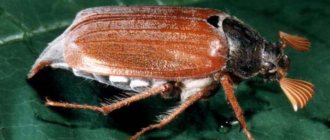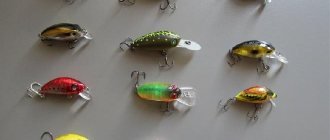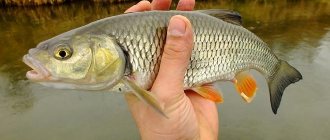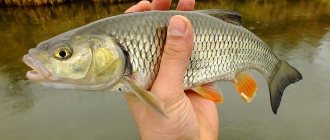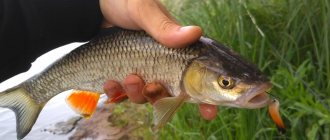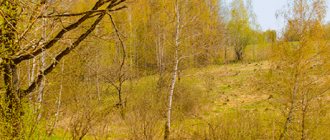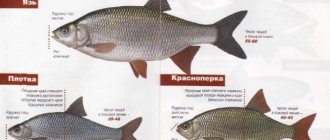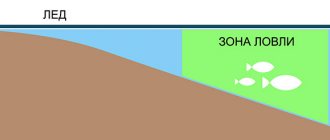May beetles appear at the end of April - beginning of May and fly over the fields and water surface almost until the end of May. Some of them, for a number of reasons, end up in the water, where a hungry chub awaits them. Around mid-May, the chub begins to switch to feeding on chafer beetles. It is during this period that the chub begins to actively hunt for May beetles, which is associated with its active behavior.
Features of the chub
The chub belongs to the carp family and inhabits freshwater bodies of water where there is a current. Prefers to be in areas of the water area where the water is rich in oxygen. For this reason, neither ponds, nor lakes, nor reservoirs are suitable for its habitat.
The chub is distinguished by a long, elongated body, which is covered with silver-colored scales with a barely noticeable golden tint. The chub has a well-developed tail and fins, which allows it to successfully navigate the current and stay on it. It grows up to 70 cm in length, weighing about 6 kg, and sometimes more.
It is not difficult to distinguish from other fish due to its wide frontal part of the head, which is slightly flattened. In addition, the chub’s snout is blunt, and its eyes are quite large.
Technique for catching chub using a cockchafer
With the appearance of chafers in free flight, the chub begins to actively peck at various tackles. Before leaving for fishing, it is enough to catch cockchafers and take care of their safety. What is needed for this:
- May beetles should not be stored in an empty jar or other container: leaf litter must be formed for them.
- We must not forget that they need oxygen. In this regard, several holes need to be made in the lid of the jar.
- If the jar is placed in a cool and not too lit place, then the beetles can remain in such conditions for a long time.
Catching chub with a cockchafer
Equipment used
To catch a chub using a cockchafer, it is enough to have one rod with a fishing line at the end of which there is one hook. It is not necessary to have a bite alarm here. You can completely do without it, especially since its presence can alert the fish, since the chub is quite shy. As a rule, fishing is carried out close to the shore and at shallow depths.
Equipment characteristics:
- To catch chub, you should take a fishing line about 0.2 mm thick. If a leash is used, its thickness should be no more than 0.18 mm.
- A float with a medium weight is suitable if the current is not very powerful, otherwise a heavier float is selected.
- When fishing with a fishing rod, the most optimal hook number is No. 4 or more.
- To rig the fishing rod you will need sinkers. The most suitable forms are a drop or an olive.
Gear selection
As a rule, chub are caught using a regular fishing rod with a float. The sizes of the rod are selected depending on the specific fishing conditions, which are associated with the nature of the reservoir.
The choice is made within the following main characteristics:
- The length of the rod blank must be at least 5 meters. At the same time, you need to take into account that the chub is a strong fish and the quality of the rod plays an important role.
- Both inertial and inertialess reels are suitable. At the same time, one should take into account the fact that a spinning reel is more preferable due to the ease of its use.
Chub can also be caught using other gear, such as:
- Spinning . It is enough to have a light spinning rod, no more than 2.5 meters long.
- Bottom tackle . Consists of a short but strong rod. It is advisable to use a feeder, which can increase the chances of catching a chub.
Place and time of fishing
Chub can be found in rivers with moderate or fast currents. No less attractive are areas of the water area where the chub has to swim against the current. This predator can also be among snags, where it waits for potential prey. The optimal depth for catching it is 2.5-3 meters.
The best time to catch chub is early morning or late evening. With the onset of spring, the chub feeds throughout the day. At the same time, the intensity of the bite is inconsistent.
Fishing technique
After the tackle is equipped with all the necessary elements, you can go fishing. The fishing technique is as follows:
- The spinning rod is thrown at an angle of 50 degrees, in the direction of the current. In such conditions, there is a possibility of a quick bite from the chub.
- After casting, you should wait for a while, waiting for a bite.
- In case of a bite, you should immediately hook.
At the same time, you need to be especially careful, since the chub is a strong fish. If you overdo it, the line may not hold up and break. To pull it out of the water, it is advisable to use a landing net if you have no experience in such situations.
Features of fishing at different times of the year
Spring
Immediately after the ice melts, in March or April, the chub does not show much activity. It is difficult to find it in the reservoir at this time, and the chances of a good catch are low. The situation improves closer to summer, after the water warms up - in April - May.
You can find fish at this time both in the depths where it spent the winter, and in shallow waters well warmed by the sun, where the chub looks for a lot of food in the spring.
Read Silver carp: benefits and harms
In April - May in most regions this fish spawns. In time it coincides with the flowering of bird cherry. During the spawning period, the chub, unlike other fish, continues to feed and fall for the bait.
But when going fishing, you must take into account that in the spring spawning bans are introduced, which vary from region to region. You should follow them, treat the fish with care and allow it to spawn in peace.
Summer
Summer is the best period for chub hunting. The fish are active at this time and bite well on a fishing rod with a float. This is especially true for June and August. In July, the activity of the chub, like any other fish, decreases.
In summer, this fish feeds mainly on insect larvae, the insects themselves, as well as algae covering driftwood. Fishing near the surface, both in the coastal zone and at depth, brings good results in June and August.
In the middle of the summer season, when the air and water temperatures rise, the fish become capricious. Figuring out how to fish for chub in the summer and still have a good catch can be challenging. At this time, you need to look for the bighead in the current and at depth, where it is cooler.
Another important question is what is the best way to catch chub in June, July, and August. At this time, you can get good results using green filamentous algae (teena). Other options are other plant baits and insects that need to be floated across the surface.
Autumn
In autumn, when the water becomes colder, the chub switches to animal food. Large specimens feed on fry at this time, and they can be successfully caught using a live bait rod. Smaller chub respond to animal baits placed on the hook of a regular float rod. You need to look for fish further from the shore, at depth.
Winter
In winter, the chub stands in holes far from the shore, where it hibernates until spring. But in some reservoirs, especially in the south, it continues to feed even after freeze-up. In such a situation, it can be caught with a winter fishing rod, float or jig.
In this case, you need to look for it at depth. On reservoirs that do not freeze in winter, you can hunt for chub using a summer float rod. At this time, you need to catch it at the bottom using animal baits.
Secrets of some fishermen
Fishing using the cockchafer as bait has some features that must be taken into account in order for the fishing to be successful. For example:
- It is advisable to determine the optimal fishing depth. When fishing in the evening, chub can be found in shallow water, and when fishing during the day, it is better to look for it in depth.
- Bites occur during periods when the chub begins to look for food, so it is better to know exactly when the chub feeds, and it feeds exclusively during cool periods, which include morning, evening and night. At the end of spring, the chub hunts for bugs and worms throughout the day. During this period, he can swallow any bait of animal origin.
- The chub is a cautious and timid fish, so you need to catch it in complete silence with elements of camouflage.
- During the fishing process, especially after the fish have disappeared, you need to take care of new promising places, since he can move away from this dangerous place for him.
- The chub may be alerted by the bright colors of the equipment. Therefore, you need to make sure that they do not stand out particularly against the general background. The ideal option is to use elements of gear that have a neutral color.
Lures
Fishing for chub with a spinning rod can disappoint many anglers. The bottom line is that most people are used to fishing with a spinning rod from the shore, and chub bite better when casting from the water, without expecting a catch. Most often, he carefully watches the shore, reacts to the sound of footsteps and the appearance of a human figure, increasing his level of vigilance.
The best thing to do is to sit in the boat and let it move freely through the water without creating additional splashes or noise. Then the chub bite is guaranteed, but only if you choose the right bait.
What to catch with? Since the chub is omnivorous, the choice of bait is extremely wide. Lures in this case are divided into 2 types:
- wobbler
- spinner
The chub really likes spinnerbaits for unknown reasons; his preferred size is No. 0 - No. 2. Lures from proven and high-quality manufacturers are suitable, for example MEPPS, MYRAN, BLUE FOX.
Most of all, chub like black and gold colors of baits. The Mepps spinner in the Black Furi shade is perfect - it is black and has orange splashes. Also, the chub will readily bite on MYRAN Panter martin Golden No. 3.
The size of the spoon will affect the size of the fish that bites. An angler who wants to catch a small chub should take a small spoon; for a medium one, a medium-sized spoon will be needed, respectively. If you want to catch a large chub, you need to take a wobbler.
If the wobbler is the Owner C'ultiva Bug Eye. You will not regret
For chub you need small wobblers, but quite large in diameter. Suitable fatties include: Owner Cultiva Bug Eye, SMITH Camion, JACKALL Chubby, ZIP BAITS Hiscory, KOSADAKA Roger surf, STRIKE PRO Warted Toad.
With the right choice of wobbler, there is a chance that the chub will bite immediately after casting the bait, based on reflex. Some manufacturers produce wobblers that imitate the swimming beetle, chafer or black water beetle, and they are especially loved by the chub.
Wobblers that copy the appearance of fry are also suitable for catching chub. Chub always bite on them, but often the bait is taken by small fish that are not valuable as a trophy for sport fishing. The choice of bait should take into account not only the size and color preferred by the chub, but also the depth at which the chub lives in a given season.
Also, a streamer will be effective in catching chub. The main feature of this type of bait is that it needs to be actively played in order for the chub to bite. You can attach several streamers at once in the colors the chub loves - black and yellow, or combine them together on a hook.
Read How to breed maggots at home in different ways
GT-BIO Cicada-Diamond spinner is an excellent alternative to a real cicada
Another great bait for chub is the cicada. It is extremely popular in European countries and the USA, but domestic fishermen, as a rule, neglect it. Chub prefer small baits in yellow and black colors, and cicada have particularly attractive movement properties to predators. If standard baits do not produce results, it is worth trying a cicada, and bites are likely even in the first seconds after casting.
In early spring, catching chub with a jig will be a pointless idea, since the predator does not like this bait. In a later period, there is a possibility that a chub in a school will bite the jig automatically, but this type of bait can be called the most ineffective when catching chub.
Methods for baiting a cockchafer on a hook
The beetle is attached to the hook using any known method.
The first way is as follows:
- At the initial stage, using a needle, a through puncture is made along the body of the cockchafer. At the same time, you need to make sure that the needle does not pierce the head, otherwise the cockchafer will die.
- After this, a hook is inserted into the resulting puncture and securely fixed. This method allows you to catch several individuals with one cockchafer.
The second method involves the following actions:
- Take a hook and use it to pierce the body of the cockchafer, with the tip of the hook coming out in the area of the head. The point of the hook does not need to be hidden, which will increase the chances of catching fish.
- After this, you can safely throw the fishing rod into the water.
Broadcast “On Fishing” May 28, 2013 Catching chub with a cockchafer on the Pregol River
